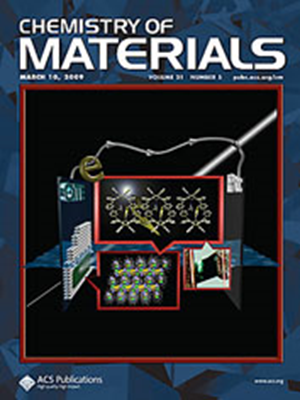Manipulation of Charged Porous Cages as Tunable Platforms for Strong Gas Adsorption
IF 7.2
2区 材料科学
Q2 CHEMISTRY, PHYSICAL
引用次数: 0
Abstract
Metal–organic frameworks (MOFs) have long been explored for their tunable structures and applications in gas separation and catalysis, yet systems capable of engaging in metal-to-ligand π-backbonding remain scarce. Expanding beyond MOFs, our study leverages porous coordination cages (PCCs) as modular building blocks to construct highly tunable porous salts. By incorporating coordinatively unsaturated, π-basic ruthenium sites within charged PCCs, we achieve selective and reversible carbon monoxide chemisorption, a property rarely observed in hybrid porous materials. We further demonstrate that nonporous molecular ruthenium complexes can be incorporated as charge-balancing counterions, yielding materials with tailored porosities and adsorption properties. These findings introduce a strategy for designing porous salts that integrate molecular reactivity with tunable porosity, offering promising avenues for next-generation separations, sensing, and catalysis. Our approach bridges molecular design principles with material functionality, expanding the toolkit for designing adaptive porous materials beyond traditional MOFs.

求助全文
约1分钟内获得全文
求助全文
来源期刊

Chemistry of Materials
工程技术-材料科学:综合
CiteScore
14.10
自引率
5.80%
发文量
929
审稿时长
1.5 months
期刊介绍:
The journal Chemistry of Materials focuses on publishing original research at the intersection of materials science and chemistry. The studies published in the journal involve chemistry as a prominent component and explore topics such as the design, synthesis, characterization, processing, understanding, and application of functional or potentially functional materials. The journal covers various areas of interest, including inorganic and organic solid-state chemistry, nanomaterials, biomaterials, thin films and polymers, and composite/hybrid materials. The journal particularly seeks papers that highlight the creation or development of innovative materials with novel optical, electrical, magnetic, catalytic, or mechanical properties. It is essential that manuscripts on these topics have a primary focus on the chemistry of materials and represent a significant advancement compared to prior research. Before external reviews are sought, submitted manuscripts undergo a review process by a minimum of two editors to ensure their appropriateness for the journal and the presence of sufficient evidence of a significant advance that will be of broad interest to the materials chemistry community.
 求助内容:
求助内容: 应助结果提醒方式:
应助结果提醒方式:


